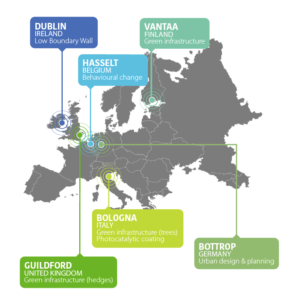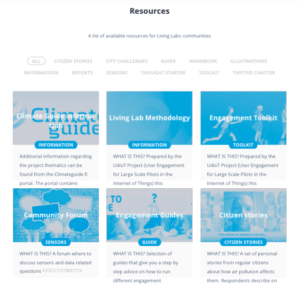The iSCAPE Living Labs
To achieve iSCAPE’s objectives, living labs were created in six European cities: Bologna, Bottrop, Dublin, Guildford, Hasselt, and Vantaa.
The iSCAPE living labs connected a great variety of stakeholders, facilitating collaboration and sharing of multidisciplinary knowledge and experience to advance air pollution remediation strategies and solutions. This included the engagement of citizens, fundamental in living lab activities to create value and increase the public awareness of air pollution control.
 To enable conversations and solutions around air quality in Europe a collaborative platform was set up at https://livinglabs.iscapeproject.eu
To enable conversations and solutions around air quality in Europe a collaborative platform was set up at https://livinglabs.iscapeproject.eu
The ISCAPE Living Labs website was targeted at all those involved in the six Living Labs but was open to anyone interested in improving air quality in cities. It contained:

- Six mini-sites (one for each Living Lab and in the main language of the respective city) where you could find information and updates on on-going activities;
- A resource page with all available resources developed for Living Lab communities (these included citizen engagement guides, toolkits and citizen stories but also living lab implementation plans and an overview of the iSCAPE sensor platform).
Through the Living Labs approach, iSCAPE partners developed different experimental interventions in the six cities, assessing and tackling the air pollution issue from different perspectives:
- Bologna (IT): a first intervention in Bologna estimated the role of trees as a Passive Control System to control the air quality inside the urban environment, relying on two field in situ measuring campaigns during winter and summer. Results were shared with local authorities to introduce new interventions, while stakeholders helped involve citizens during the experiments. In Lazaretto, a second intervention allowed to estimate the impacts of the use of photocatalytic coatings on a campus building. The test were conducted estimating pollutants concentrations pre and post application of coats. Each part of the project was shared with students and campus employees.
- Bottrop (DE): for the iSCAPE intervention in Bottrop, trees travelled around the city: The potted “Wandering Trees” were used to temporarily green inner-city streets. The implementation of the living lab included a broad involvement of local stakeholders and the general public.
- Dublin (IE): by conducting a long-term study, the Dublin living lab provided evidence on the effectiveness of low boundary walls (LBW). During this study, a sensor network was deployed to assess the impact of an LBW already in place, as well as consulting city stakeholders and engage the general public to assist in the aesthetic and functional design of a new LBW through participatory events and playful approaches, such as using Lego bricks.
- Guildford (UK): iSCAPE results in Guildford were envisioned as a portable, insightful, and user-interactive platform for raising citizens’ awareness about air pollution issues in their neighbourhood and the use of green infrastructural interventions (such as trees and hedges) to combat pollution exposure, thereby improving the community’s health and well-being.
- Hasselt (BE): the intervention triggered and analysed behavioural changes by providing a dedicated app to a population sample to observe their travel patterns. The intervention included offering customised information to participants in relation to their exposure to pollutants, contribution in CO2 emissions and physical activity level.
- Vantaa (FI): the intervention ‘Influence of green roofs and parks on air quality and human well being’ established a platform for stakeholders such as city authorities and inhabitants to combine their common effort for better city planning.
To find out more about the Living Labs activities see the following brochure (pdf)
When the platform will no longer be live all relevant resources will be included within this page.
